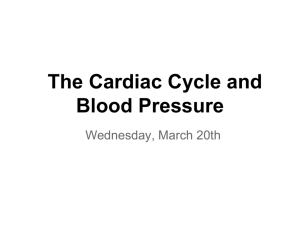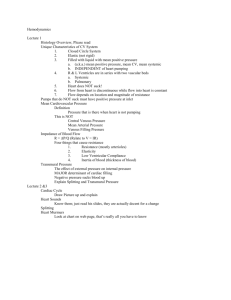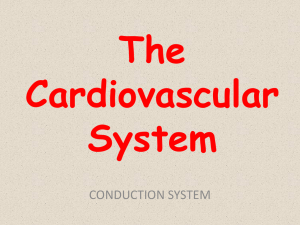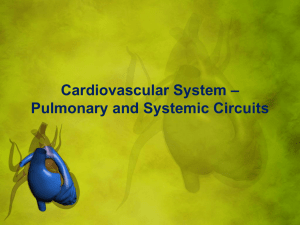Introduction to Cardiac Cycle and Cardiac Output - squ
advertisement
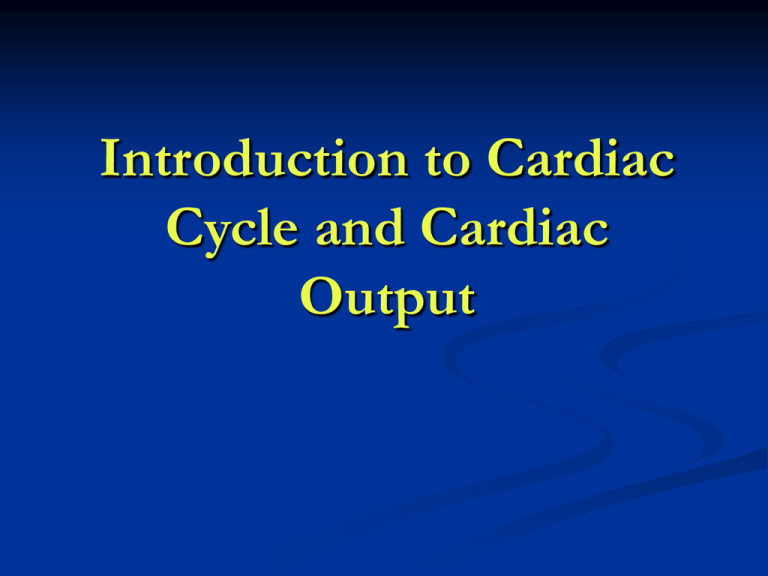
Introduction to Cardiac Cycle and Cardiac Output Objectives Explain the ECG waves and correlate them with mechanical events. Describe the phases of cardiac cycle. Identify the origin of heart sounds. Define heart rate, stroke volume, venous return and cardiac output. Explain the Starling’s law of the heart. List the function of autonomic nervous system on the heart. Electrocardiogram ECG (EKG) Electrocardiogram ECG (EKG) • Surface electrodes record electrical activity deep within body • Reflects electrical activity of whole heart not of single cell! • EC fluid = “salt solution” (NaCl) good conductor of electricity to skin surface ECG tracing = of all electrical potentials generated by all cells of heart at any given moment Electrocardiogram (ECG, EKG) Electrodes placed on arms and legs (limb leads) + six positions on chest (chest leads). Each lead records different electrical activity (each looks at heart from a different position) 3 waves appear with each heart beat: P wave: represents atrial depolarization QRS complex: represents ventricular depolarization T wave: represents ventricular repolarization Since: Depolarization = signal for contraction Segments of ECG reflect mechanical heart events Correlation of ECG waves with Atrial and Ventricular Systole ECG cont. Comparing records with one another & normal records, allows determination : if conductivity pathway is normal if the heart is enlarged if certain regions of heart are damaged ECG time intervals or segments: P-Q interval S-T interval Q-T interval ECG cont. Cardiac Cycle One cardiac cycle (CC): all events associated with one heart beat. (Systole and diastole of atria + systole and diastole of ventricles) At HR 75 beats /min, CC lasts 0.8 secs. In each CC, atria & ventricles alternatively contract & relax Force blood from areas of higher pressure Areas of lower pressure Cardiac Cycle cont. Cardiac Cycle comprises the following phases: Atria systole: atria contracting but Ventricles relaxing. Lasts 0.1 sec Ventricular systole: Ventricular Contracting while atria relax (atrial diastole). Lasts 0.3 sec. Relaxation Phase (Complete cardiac diastole ), Both atria and ventricular relax. Lasts about 0.4 sec Heart Sounds Auscultation: act of listening to sounds within the body, usually done with a stethoscope sounds are caused by vibrations set up within the walls of ventricles and major arteries during valve closure. During each CC4 heart sounds Only first & second (S1 &S2) heard in normal heart First heard sound (S1) lubb: - louder & longer than second - caused by closure of A-V valves (soon after beginning of ventricular systole) Second heart sound (S2) dupp: - shorter & not as loud as first - caused closure of SL valves (beginning of ventricular diastole) S3 is due to turbulance during ventric filling S4 is due to turbulance during atrial systole Heart sounds S1 &S2 are best heard at the surface of chest in specific locations Cardiac output (CO) CO is the volume of blood ejected from the left ventricle (or the right ventricle) into the aorta (or pulmonary trunk) each minute. CO equals the stroke volume (SV) multiplied by heart rate (HR) CO = SV X HR SV volume of blood ejected by the ventricle during each contraction HR number of heart beats per minute. CO = SV X HR = 70 ml/beat X 75 beats/minute = 5.25 L/min Cardiac Output cont. CO may to meet demands During exercise CO can increase to 20-25 L/ min Cardiac reserve (CR): The difference between the maximum CO and CO at rest. Average CR: 4 -5 X resting value (20-25 L/m) higher in athletes (35 L/m) little or no reserve in heart disease Regulation of cardiac output CO= SV x HR Depends on the regulation of SV and HR Cardiac Terminology End diastolic volume (EDV): blood in the ventricles at the end of diastole. Ejection fraction: fraction of EDV that is ejected (%), used to measure heart efficiency. End systolic volume (ESV): blood that remains in the blood at the end of systole. Preload: the degree of stretch on the heart before it contracts. Afterload: the pressure that must be exceeded before ejection of blood from the ventricles can occur. Regulation of stroke volume THREE factors regulate SV: 1.Preload (EDV) 2.Contractility 3.Afterload 1. Preload: effect of stretching Frank-Starling (F-S) law of the heart: Within limits, the more the heart fills during diastole (preload – stretching), the greater the force of contraction during systole. the preload is proportional to EDV, the greater the EDV, the more forcefull the next contraction “The heart will pump what it receives”Starling’s law of the heart Preload cont. Two factors determine EDV: Duration of ventricular diastole (HR) Ventricular filling occur during diastole Tachycardia ( HR) diastole duration ventricular filling end diastolic volume CO 2. Venous return (volume of blood flowing back to the heart through systemic veins) 1. 2. Contractility Contractility: strength of contraction at any given preload +ve inotropism: contractility Include: - sympathetic stimulation - Hormones; adrenaline and noradrenaline -ve inotropism: contractility May result from: - inhibition of the sympathetic system - anoxia - acidosis 3. Afterload pressure in pulmonary tract is a bout 20 mm.Hg and in the aorta is about 80 mm Hg. This pressure must be overcome before the semilunar valves open. Depend on: Elasticity of large arteries Peripheral resistance of arterioles An in afterload SV more blood remains in ventricle at end of systole (ESV) Conditions that afterload include: Hypertension Narrowing of arteries by atherosclerosis Regulation of heart rate Several factors, the most important are 1. Nervous factors 2. Chemical factors 3. Others Autonomic regulation of HR Chemical regulation of HR 1. Hormones: Adrenaline and noradrenaline (adrenal medulla) HR & contractility Adrenal medulla stimulated by: exercise stress excitement Thyroid hormones HR & Contractility Hyperthyroidism tachycardia 2. Cations Na+ & K+ HR & Contractility Ca2+ HR & Contractility Other factors in HR regulation Age: Newborn HR ~120 beats/min Old people may also develop HR Gender: Adult females higher HR than males Exercise: Athletic bradycardia (60 or under) (more efficient heart) Body temperature (BT): BT (fever or exercise) HR BT HR & contractility
